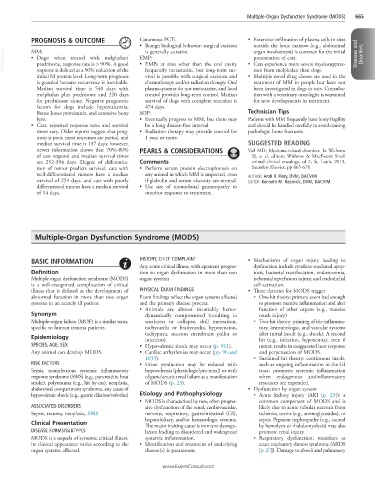Page 1317 - Cote clinical veterinary advisor dogs and cats 4th
P. 1317
Multiple-Organ Dysfunction Syndrome (MODS) 665
PROGNOSIS & OUTCOME Cutaneous PCT: • Extensive infiltration of plasma cells in sites
• Benign biological behavior: surgical excision outside the bone marrow (e.g., abdominal
VetBooks.ir • Dogs: when treated with melphalan/ EMP: • Cats experience more severe myelosuppres- Diseases and Disorders
organ involvement) is common for the initial
is generally curative.
MM:
presentation of cats.
prednisone, response rate is > 90%. A good
• EMPs at sites other than the oral cavity
response is defined as a 50% reduction of the
sion from melphalan than dogs.
initial M protein level. Long-term prognosis frequently metastasize, but long-term sur- • Multiple novel drug classes are used in the
vival is possible with surgical excision and
is guarded because recurrence is inevitable. chemotherapy and/or radiation therapy. Oral treatment of MM in people but have not
Median survival time is 540 days with plasmacytomas do not metastasize, and local been investigated in dogs or cats. Consulta-
melphalan plus prednisone and 220 days control provides long-term control. Median tion with a veterinary oncologist is warranted
for prednisone alone. Negative prognostic survival of dogs with complete resection is for new developments in treatment.
factors for dogs include hypercalcemia, 474 days.
Bence Jones proteinuria, and extensive bony SOP: Technician Tips
lysis. • Eventually progress to MM, but there may Patients with MM frequently have bony fragility
• Cats: reported response rates and survival be a long disease-free interval and should be handled carefully to avoid causing
times vary. Older reports suggest that prog- • Radiation therapy may provide control for pathologic bone fractures.
nosis is poor, most responses are partial, and 1 year or more.
median survival time is 137 days; however, SUGGESTED READING
newer information shows that 70%-80% PEARLS & CONSIDERATIONS Vail MD: Myeloma-related disorders. In Withrow
of cats respond and median survival times SJ, et al, editors: Withrow & MacEwen’s Small
are 252-394 days. Degree of differentia- Comments animal clinical oncology, ed 5, St. Louis, 2013,
tion of tumor predicts survival; cats with • Perform serum protein electrophoresis on Saunders Elsevier, pp 665-678.
well-differentiated tumors have a median any animal in which MM is suspected, even AUTHOR: Andi B. Flory, DVM, DACVIM
survival of 254 days, and cats with poorly if globulin and serum viscosity are normal. EDITOR: Kenneth M. Rassnick, DVM, DACVIM
differentiated tumors have a median survival • Use size of monoclonal gammopathy to
of 14 days. monitor response to treatment.
Multiple-Organ Dysfunction Syndrome (MODS)
BASIC INFORMATION HISTORY, CHIEF COMPLAINT • Mechanisms of organ injury leading to
Any acute critical illness, with apparent progres- dysfunction include cytokine-mediated apop-
Definition sion to organ dysfunction in more than two tosis, bacterial translocation, endotoxemia,
Multiple organ dysfunction syndrome (MODS) organ systems ischemia/reperfusion injury, and endothelial
is a well-recognized complication of critical cell activation.
illness that is defined as the development of PHYSICAL EXAM FINDINGS • Three theories for MODS trigger
abnormal function in more than two organ Exam findings reflect the organ systems affected ○ One-hit theory: primary event bad enough
systems in an acutely ill patient. and the primary disease process. to promote massive inflammation and alter
• Animals are almost invariably hemo- function of other organs (e.g., massive
Synonym dynamically compromised (resulting in crush injury)
Multiple-organ failure (MOF) is a similar term, weakness or collapse, dull mentation, ○ Two-hit theory: priming of the inflamma-
specific to human trauma patients. tachycardia or bradycardia, hypotension, tory, immunologic, and vascular systems
tachypnea, mucous membrane pallor or after initial insult (e.g., shock). A second
Epidemiology injection). hit (e.g., infection, hypoxemia), even if
SPECIES, AGE, SEX • Hypovolemic shock may occur (p. 911). minor, results in exaggerated host response
Any animal can develop MODS. • Cardiac arrhythmias may occur (pp. 96 and and perpetuation of MODS.
1033). ○ Sustained-hit theory: continuous insult,
RISK FACTORS • Urine production may be reduced with such as ongoing inflammation in the GI
Sepsis, noninfectious systemic inflammatory hypovolemia (physiologic/pre-renal) or with tract, promotes systemic inflammation
response syndrome (SIRS) (e.g., pancreatitis, heat oliguric/anuric renal failure as a manifestation when endogenous antiinflammatory
stroke), polytrauma (e.g., hit by car), neoplasia, of MODS (p. 23). resources are expended.
abdominal compartment syndrome, any cause of • Dysfunction by organ system
hypovolemic shock (e.g., gastric dilation/volvulus) Etiology and Pathophysiology ○ Acute kidney injury (AKI [p. 23]): a
• MODS is characterized by new, often progres- common component of MODS and is
ASSOCIATED DISORDERS sive dysfunction of the renal, cardiovascular, likely due to acute tubular necrosis from
Sepsis, trauma, neoplasia, SIRS nervous, respiratory, gastrointestinal (GI), ischemia, toxins (e.g., aminoglycosides), or
hepatobiliary, and/or hematologic systems. sepsis. Pigment nephropathy (e.g., caused
Clinical Presentation The major inciting cause is immune dysregu- by hemolysis or rhabdomyolysis) may also
DISEASE FORMS/SUBTYPES lation leading to disordered and widespread promote renal injury.
MODS is a sequela of systemic critical illness; systemic inflammation. ○ Respiratory dysfunction: manifests as
its clinical appearance varies according to the • Identification and treatment of underlying acute respiratory distress syndrome (ARDS
organ systems affected. disease(s) is paramount. [p. 27]). Damage to alveoli and pulmonary
www.ExpertConsult.com

